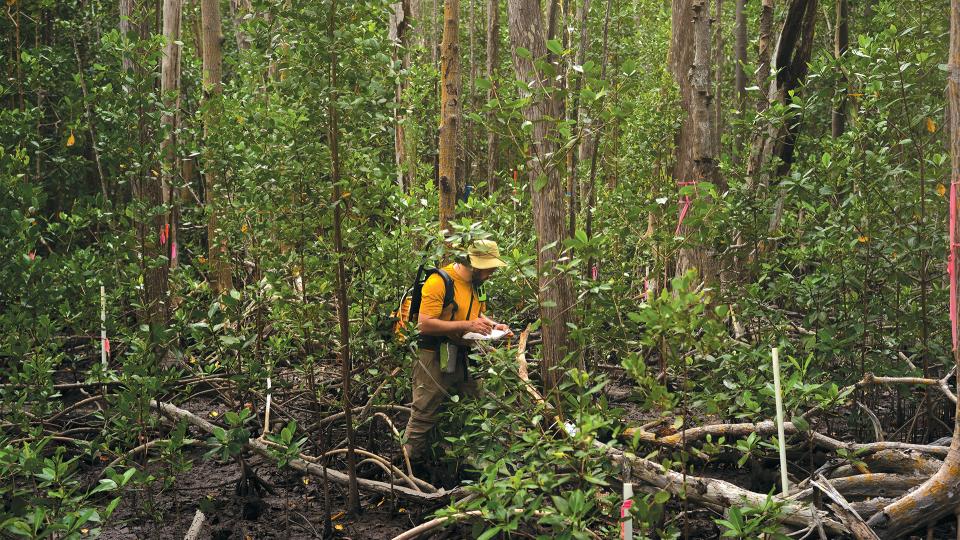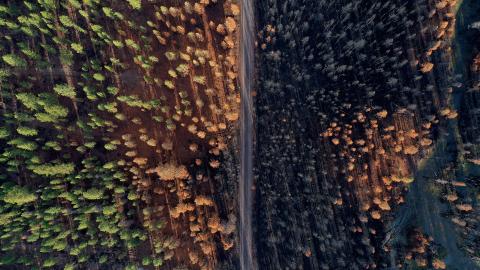
PhD student Jonathan Gewirtzman makes observations in the Florida Everglades as a member of a research team examining greenhouse gas emissions from mangrove trees and the ecosystem's blue carbon storage potential. Photo: Isaac Zapata
Exploring the Depths of Water’s Role in Climate Change
Aquatic ecosystems play an essential role in the greenhouse gas emissions cycle. Water bodies can sequester carbon — and they can also release emissions. Reducing these emissions and exploring ways of increasing their potential for carbon uptake is at the center of new climate research at YSE.
Covering nearly three-quarters of the Earth, surface water plays a critical role in the carbon cycle of the planet by storing and also emitting greenhouse gases. But exactly how much of a role it plays and its potential to help mitigate climate change is still a question.
In the past year, Ben Girgenti ’22 MESc has been chest deep in mud at the Yale Nature Preserve to create buckets of mini wetlands to test methods for reducing emissions.
In Vermont’s Northeast Kingdom, YSE Professors Peter Raymond and Jim Saiers, joined by their colleague Yale Associate Professor of Earth and Planetary Sciences Noah Planavsky, are working together with a team of students to spread crushed rocks on a watershed.
And in the southern U.S., Jonathan Gewirtzman, PhD student, and Frannie Adams ’23 MESc are measuring methane emissions to explore the effects of climate-driven disturbances in the Florida Everglades.
They are among several YSE researchers working on two key projects involving water ecosystems: reducing emissions and increasing carbon uptake.
The Emissions Factor
As world leaders seek to keep global warming to 1.5 degrees Celsius over preindustrial times to avoid the most devastating and widespread impacts of climate change, deepening our understanding of how much the emissions of water bodies contribute to the global budget has become an increasing focus of the international scientific community.
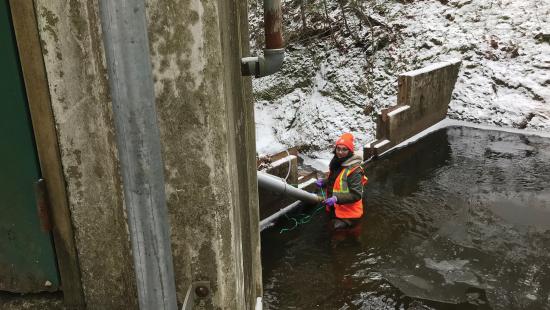
Laura Logozzo has been taking samples from water bodies in Connecticut to examine dissolved carbon and other measurements relating to water quality. Here she performs maintenance on water quality probes in Bunnell Brook.
Up until 10 years ago, there was no definitive count of the full surface area of water bodies on the planet. In 2013, Raymond and colleagues developed the first global map of their surface area and carbon emissions. They found that water bodies are emitting 2 billion tons of carbon as CO2 each year. Their report, published in the journal Nature and one of Raymond’s most cited research studies, prompted further inquiry into anthropogenic emissions and fluxes.
“It’s mostly part of the natural process, not like fossil fuel emissions,” says Raymond, professor of ecosystem ecology, whose undergraduate work focused on carbon dioxide emissions in the Hudson River. “But when you are trying to figure out how much anthropogenic emissions there are and fluxes in different regions, it becomes important to know, and it’s a number that is big enough to be considered in global modeling of atmospheric CO2.”
It is not just how much carbon and other greenhouse gases are being emitted and stored by water bodies that have the attention of YSE researchers. It is also the age of dissolved carbon in water bodies.
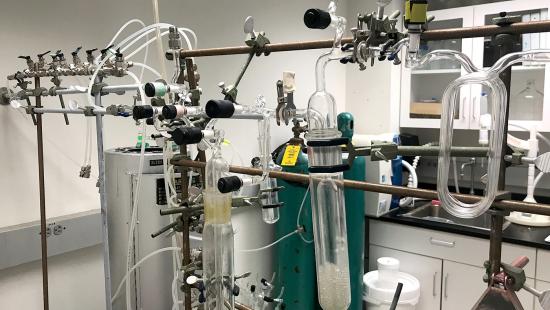
A photooxidation chamber and vacuum line in Professor Peter Raymond’s lab is used to convert dissolved organic carbon into carbon dioxide to measure carbon age.
PhD student Laura Logozzo has been taking samples from the Connecticut River to ascertain the age of dissolved organic carbon. For the past two years, she has taken samples from five different areas along its span to do what has not been done before: focus on the age of dissolved organic carbon in a river over time.
What she has found from her samples — and older ones stored in the lab dating back more than five years — has raised a possibly troubling issue that needs further inquiry: Dissolved organic carbon found in the river samples is significantly older than previous samples.
“This means that the amount of old carbon compared to fresh carbon entering the river is increasing,” she says.
If a river has older dissolved organic carbon present, it means that the carbon once stored in terrestrial soils and forests has been entering the river and could be a new source of carbon dioxide being released into the atmosphere. While research has not yet determined the cause of the presence of older dissolved carbon in the river, it could be a result of droughts caused by climate change. The urbanization of watersheds and agricultural use could also cause the dredging up of older carbon soil pools that are then exposed and washed into rivers.
“And that’s bad because you’re basically losing whatever carbon is stored on land,” explains Logozzo. “If you’re not measuring the carbon that’s actually leaving those soils into rivers, then you may be overestimating how good these ecosystems are at storing carbon.”
Not Just About Carbon
To get a more complete account of emissions from water bodies, YSE researchers also are examining methane and nitrous oxide emissions. While it only persists in the atmosphere for a dozen or so years, methane traps heat far more effectively than carbon dioxide and accounts for 25% of atmospheric warming in the industrial era. Nitrous oxide molecules are roughly 300 times more effective in warming than carbon dioxide molecules and, unlike methane, can persist in the atmosphere for over a century.
Last spring, a study by a team of researchers led by postdoctoral associate Judith Rosentreter and co-authored by Raymond, found that aquatic ecosystems and wetlands contributed at least half of the total global methane emissions budget. The authors reviewed methane fluxes from 15 major natural, human-made, and human-impacted aquatic ecosystems and wetlands — including inland, coastal, and oceanic systems. The combined emissions from these aquatic ecosystems are potentially a larger source of methane than direct anthropogenic methane sources, such as agriculture or fossil fuel combustion. The amount emitted from these aquatic ecosystems is also impacted by human activity and is important to track, the study notes.
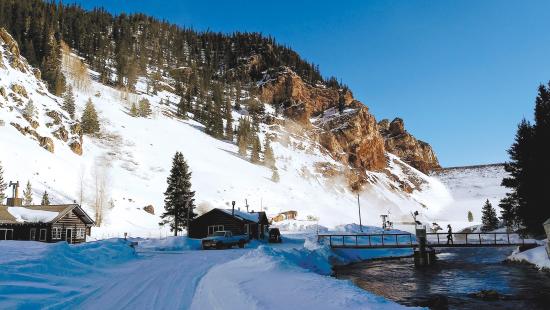
Postdoctoral fellow Taylor Maavara collects samples from Colorado’s Gunnison River (below) and from a site downstream of Taylor Park Dam at the Colorado River headwaters (above) to analyze how dams impact greenhouse gas emissions from water bodies.
Taylor Maavara, a YSE postdoctoral fellow, has been exploring a unique area of study: how dams, a key component of hydroelectric power, affect nitrous oxide and other greenhouse gas emissions. In the coming years, almost 90% of the Earth’s rivers will have dams. And while they provide less carbon-intensive sources of energy at the point of generation, hydroelectric dams impact water body emissions in significant ways.

“There are potentially up to 70,000 medium-to-large reservoirs on Earth. And if you’re trying to extrapolate the amounts of emissions from just the 50 reservoirs that have been studied, there’s just massive uncertainty,” she says.
Her research has focused on, among other things, how much nitrous oxide is emitted from reservoirs, rivers, lakes, and estuaries — and it is high.
“Inland waters are emitting roughly the same amount of nitrous oxide as a country in Europe. That’s a significant amount,” Maavara says. “Another finding was that reservoirs were the most efficient inland water emitters. As we continue to dam, we’re going to potentially increase the emission of nitrous oxide from inland water sources.”
To mitigate this, she advocates for pulling back from the notion that dams must be permanent and suggests reconfiguring dam operation schedules.
“We really need a plan for the whole life cycle of a dam. We have to get away from the idea that we are building a dam forever. Dams should have a timeline. And after a certain point, they should be decommissioned and deconstructed,” she says.
The Promise of Blue Carbon
While water bodies are sources of emissions, whether human induced or from natural cycling, they also store carbon at levels that show promise as a natural climate solution.
The term “blue carbon” was first coined in 2009 as a nod to the potential of these ecosystems that store carbon to help limit the global average temperature rise to well below 2 degrees Celsius — an atmospheric tipping point. Blue carbon ecosystems (BCEs), which include salt marshes, mangroves, and seagrasses, each sequester more carbon per hectare per year than tropical forests.
The degradation and clearing of coastal ecosystems cause emissions of between 0.15 and 1.02 billion tons of carbon dioxide into the atmosphere each year, according to the study “Estimating Global ‘Blue Carbon’ Emissions from Conversions and Degradation of Vegetated Coastal Ecosystems” published in PLOS ONE. These emissions are equivalent to 3%–19% of those from deforestation globally, the study notes.
Yet only about 1.5% of global BCEs are currently included in marine protection areas. Preserving, managing, and restoring these ecosystems globally, alongside seaweed farming, could reduce emissions by as much as 1.4 billion tons of CO2 equivalent emissions annually by 2050, according to a 2019 High Level Panel for a Sustainable Ocean Economy report.
Quantifying the potential BCEs have for carbon storage and how to maximize it is the focus of several new field experiments being carried out by YSE researchers.
Raymond’s lab will be using a new Swiss-built instrument the size of a small car to calculate timelines of blue carbon sequestration cycles from samples he hopes to gather with partners from water bodies all over the world. This will enable researchers to better understand the sequestration process and ways to enhance it, Raymond says.
Into the Mangroves
With funding from NASA and the Yale Center for Natural Carbon Capture, Adams and Gewirtzman, the students from Raymond’s lab doing fieldwork in Florida, are examining the effects of degradation from climate change and extreme weather events on the blue carbon storage abilities of the Everglades, as well as whether the damage increases methane emissions.
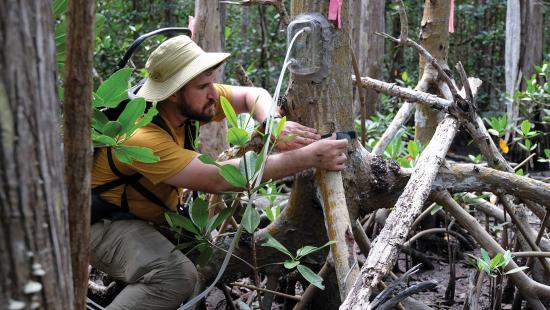
PhD student Jonathan Gewirtzman affixes a flux chamber connected to a portable greenhouse gas analyzer to a red mangrove tree in the Everglades to calculate the rate of greenhouse gas emissions. Photo: Isaac Zapata
Sea level rise, agriculture, hurricanes, changes in water flow, and regional development have contributed to degradation of the Everglades.
NASA will be leading aerial flights over the area to test for emissions in the atmosphere. YSE’s team will be focusing on methane emissions from the trees and water bodies that could offset carbon uptake and storage in the ecosystem, Gewirtzman says.
The research will help quantify the potential of blue carbon ecosystems, helping to inform ecosystem conservation and management, climate modeling, and the carbon credit marketplace.
“We’re trying to get a sense of what the vulnerability is of carbon stored in these systems to a changing climate,” Gewirtzman says.

Frannie Adams ’23 MESc examines red mangrove seedlings in the Everglades as part of her research on tree methane fluxes in disturbed and undisturbed blue carbon ecosystems. Photo: Isaac Zapata
Mangroves are among the most carbon-rich forests in the tropics, but in the past 50 years, between 30%–50% of mangroves have been lost globally, according to the Blue Carbon Initiative.
“With the work we are doing, we’ll be able to have a better assessment of precisely how influential mangroves are as a blue carbon sink,” says Adams. “I think one of the most exciting findings would be if the restored sites and the undisturbed sites are doing significantly better than the disturbed sites. Then we could make a stronger case for restoration and protection of mangroves.”
Migrating Salt Marshes
Shimon Anisfeld, YSE senior lecturer and research scientist in water resources and environmental chemistry, has been tracking the impact of climate change on salt marshes, which store carbon in peat. Sea level rise has been a main pressure on coastal salt marshes, which can lead to their collapse and the release of carbon.
“I fear that in 50 years, with accelerating sea level rise, a lot of our marshes will disappear,” Anisfeld says.
His studies show the need for planning for marsh migration to protect them so they can continue to store carbon and be a natural buffer against storms. This means less development in coastal areas, where homes often abut salt marshes.
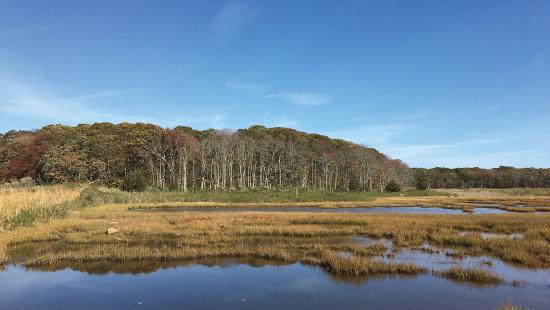
Sea level rise is making marshes wetter but also allowing them to move upslope into coastal forests, as YSE researchers are discovering at the Barn Island Wildlife Management Area in Stonington, Connecticut.
“We need to plan around marsh migration corridors and leave room for them,” he says.
“A managed retreat from the coast is compatible with allowing room for salt marshes.”
Liz Plascencia ’22 MEM, who completed an independent study on blue carbon with Anisfeld, says the new research will help the public and policymakers understand the importance of protecting marshes.
“This is not unproductive land. It’s an incredibly productive ecosystem with a plethora of co-benefits. I hope that we are able to share the blue carbon sequestration potential of salt marshes to help garner more attention from land use managers and policymakers,” Plascencia says.
New Experiments Aimed at Reducing Methane
Another promising area of research being explored at YSE is the reduction of biological methane emissions by adding minerals in wetland ecosystems that also store carbon.
To pursue reductions in emissions, Girgenti, from Raymond’s lab, created 72 mesocosms of mini wetlands in buckets using 1,200 pounds of marsh sediments from the Yale Nature Preserve to test whether adding minerals such as iron would decrease methane emissions.
By adding iron to the soil, Girgenti explains, microorganisms will preferentially use it as their electron acceptor in their metabolism instead of organic compounds that result in the production of methane. This is because the iron reduction pathway gives microorganisms more energy.
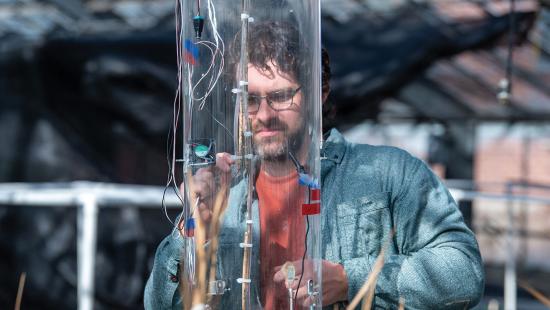
Ben Girgenti ’22 MESc measures gas emissions with a chamber he constructed as part of research into whether adding minerals to wetlands could reduce methane gas emissions. Photo: Cloe Poisson
So far, the addition of iron worked — in the lab buckets at least, says Girgenti, who regularly tested the air through an intricately designed closed chamber he constructed himself to obtain the methane readings. “It is a very quick response where the production of methane is just shut off,” he says.
The hope is to transfer that success to natural wetlands.
“If you’re building or using wetlands for natural carbon capture, you could shut off or decrease methane emissions, reducing the amount of time it takes for wetlands to begin having new sequestration of carbon,” Girgenti says.
Girgenti also is studying ways to increase the natural weathering process to reduce emissions. To pursue this, he added basalt to some of his mini mesocosms. However, chemical weathering takes time, so it is too soon to tell if the addition of the basalt is working.
Enhancing Carbon Uptake
In Vermont this spring, Jim Saiers, working with Raymond and Planavsky, is overseeing a team spreading crushed basalt to a pasture with a stream running through it to examine enhanced weathering in a watershed. Weathering happens when rainwater and snowmelt interact with rocks and soil and dissolve minerals, and carbon dioxide is converted to bicarbonate, which sequesters the carbon dioxide and removes it from the atmosphere.
“Lowering greenhouse gas emissions is paramount, but we will also need to capture carbon dioxide from the atmosphere to achieve climate stabilization targets. Enhanced mineral weathering may be among the practical instruments of CO2 removal,” says Saiers, who is Clifton R. Musser Professor of Hydrology.
This is one of the first times this type of enhanced natural weathering process will be tested at the watershed scale, he says.
The research team also is examining how CO2 consumption rates change with time, how often to apply basalt, and which types of rocks work better than others.
“One of the things that we hope we can do with the Vermont watershed is to figure out techniques and approaches that are good for quantifying carbon capture. And these techniques can be applied to other places, not just by us but by other scientists and managers,” Saiers says.
If it works and carbon capture is enhanced, it will be one tool to help mitigate climate change.
“It can be part of the solution, but it isn’t going to solve it,” says Saiers. “It’s one tool in the toolbox, but it can’t be a substitute for lowering emissions.”
All this YSE research will help get a firm handle on emissions and absorption of greenhouse gases by water bodies, how important this is for the global budgets, and how we might manage these systems to mitigate net emissions — information that could prove invaluable as the window to avoid the most severe impacts of climate change to people and ecosystems continues to shrink.
Editors Note (March 23, 2023): Laura Logozzo is now a postdoc fellow at the University of Lethbridge in Alberta, Canada.
